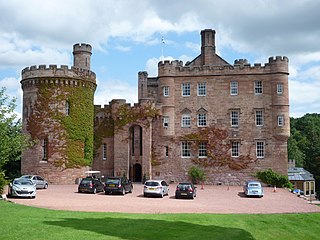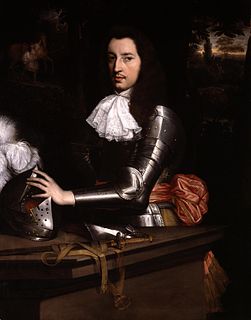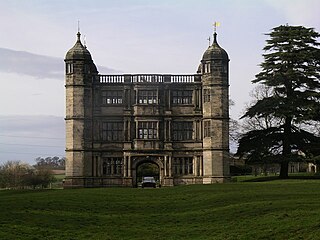
Earl of Dalhousie, in the County of Midlothian, is a title in the Peerage of Scotland, held by the Chief of Clan Ramsay.

Henry Howard, 6th Duke of Norfolk was an English nobleman and politician. He was the second son of Henry Howard, 22nd Earl of Arundel, and Lady Elizabeth Stuart. He succeeded his brother Thomas Howard, 5th Duke of Norfolk after Thomas's death in 1677.

Lord Aston of Forfar was a title in the Peerage of Scotland. The barony was created on 28 November 1627 for Sir Walter Aston, Bt, who had been previously created Baronet of Tixall Hall, Staffordshire on 22 May 1611.

Walter Aston, 1st Lord Aston of Forfar was an English courtier and diplomat.
Walter Aston, 2nd Lord Aston of Forfar was the second and eldest surviving son of Walter Aston, 1st Lord Aston of Forfar, and Gertrude Sadleir, daughter of Sir Thomas Sadleir of Standon, Hertfordshire, and his second wife Gertrude Markham. Lady Aston was the granddaughter of the noted Elizabethan statesman Sir Ralph Sadler.
Walter Aston, 3rd Lord Aston of Forfar was the eldest son of Walter Aston, 2nd Lord Aston of Forfar, and his wife Lady Mary Weston, daughter of Richard Weston, 1st Earl of Portland. He is best remembered today as a fortunate survivor of the Popish Plot.

Walter Aston, 4th Lord Aston of Forfar was the eldest surviving son of Walter Aston, 3rd Lord Aston of Forfar, and his first wife Eleanor Blount of Soddington, daughter of Sir Walter Blount, 1st Baronet.
James Aston, 5th Lord Aston of Forfar was a son of Walter Aston, 4th Lord Aston of Forfar, and Lady Mary Howard.
Walter Aston, 7th Lord Aston of Forfar, succeeded his brother Philip Aston, 6th Lord Aston of Forfar, as Lord Aston of Forfar in the peerage of Scotland in 1755.

Walter Aston, 8th Lord Aston of Forfar was the son of Edward Aston and Anne Bayley.
Walter Aston, 9th Lord Aston of Forfar was a son of Walter Aston, 8th Lord Aston of Forfar, and Anne Hutchinson. He was an ordained clergyman of the Church of England, and became the Vicar of Tardebigge, Worcestershire and Tamworth, Warwickshire.

Richard Weston, 1st Earl of Portland, KG, was Chancellor of the Exchequer and later Lord Treasurer of England under James I and Charles I, being one of the most influential figures in the early years of Charles I's Personal Rule and the architect of many of the policies that enabled him to rule without raising taxes through Parliament.
The Clifford-Constable Baronetcy, of Tixall in the County of Staffordshire was given to Thomas Hugh Clifford-Constable, originally Thomas Hugh Constable Clifford. The title in the Baronetage of the United Kingdom was created on 22 May 1815 and at the request of Louis XVIII of France.

There have been two baronetcies created for persons with the surname Aston, both in the Baronetage of England. Both creations are extinct.
Tichborne Aston was an Irish politician.

Tixall Gatehouse is a 16th-century gatehouse situated at Tixall, near Stafford, Staffordshire and is all that remains of Tixall Hall which was demolished in 1927. The gatehouse is a Grade I listed building. Tixall was used as a prison for Mary, Queen of Scots for two weeks in 1586.
Stephen Dugdale (1640?-1683) was an English informer, and self-proclaimed discoverer of parts of the Popish Plot. He perjured himself on numerous occasions, giving false testimony which led to the conviction and execution of numerous innocent men, notably the Catholic nobleman Lord Stafford, the Jesuit Provincial Thomas Whitbread, and the prominent barrister Richard Langhorne.
Andrew Bromwich was an English Roman Catholic priest. He was a survivor of the Popish Plot, and the founder of the Oscott Mission in Staffordshire, which later became St. Mary's College, Oscott.
Walter Aston may refer to:
Sir William Aston (1613-1671) was an English born barrister, politician and soldier, who fought with distinction in Ireland for King Charles I during the English Civil War. Although he made his peace with the Cromwellian regime after the King's defeat, he is believed to have remained a convinced Royalist at heart. He was rewarded for his loyalty to the Crown with a seat on the Irish High Court Bench after the Restoration. His eldest son was hanged for murder in 1686. His last direct male descendant, also named William Aston, was the de jure 6th Lord Aston of Forfar.







